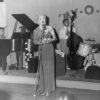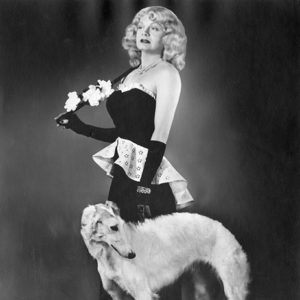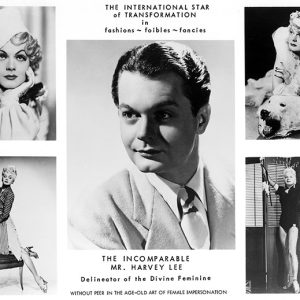calsfoundation@cals.org
Harvey Wilson Goodwin (1912–1992)
aka: Harvey Lee
Harvey Wilson Goodwin, who used the stage name Harvey Lee, was a gifted stage performer, singer, and internationally recognized female impersonator during the decades of the 1930s, 1940s, and 1950s.
Harvey Wilson Goodwin was born on August 14, 1912, in Little Rock (Pulaski County) to Ernest Eugene Goodwin, who was a contractor, and Ella Lorena (Hicks) Goodwin, who was a homemaker; he had three siblings. His family apparently recognized and supported his early interest in the theater because his father reportedly arranged makeshift stages out of canvas and drapery material for Goodwin’s neighborhood theatrical performances. Goodwin attended elementary school in Little Rock, graduated from Little Rock High School in 1930, and briefly attended business school before he left for Washington DC, where he found employment as a clerical worker for the U.S. Bureau of Public Health. He also studied dance and music, making his first appearance as a female impersonator in a 1933 dance recital. While retaining his clerical job in Washington DC, Goodwin polished his skills as a female impersonator and performed evenings and weekends around the East Coast. Goodwin subsequently performed as a female impersonator in locations such as Arkansas, California, Texas, Louisiana, Minnesota, Oregon, France, and Germany.
Goodwin began his professional employment as a female impersonator when New York City’s Club Richman hired him in 1934, whereupon he resigned from the U.S. Bureau of Public Health. During his employment with Club Richman, Warner Bros.–Vitaphone Movie Studio offered him a featured role as a femme fatale in the movie The City Slicker. Goodwin was compared to the movie star Jean Harlow, who at the time was at the height of her movie career. Goodwin’s theatrical career flourished until 1936, when he was rushed to a Baltimore, Maryland, hospital with a 104-degree fever. He was diagnosed with pneumonia, but X-rays later revealed that Goodwin had tuberculosis. From 1936 to 1941, Goodwin nursed his health in a sanatorium, and doctors recommended that he leave show business for more sedate employment.
In 1941, Goodwin returned to Arkansas and secured clerical employment at Camp Joseph T. Robinson in North Little Rock (Pulaski County). There, soldiers and civilians learned of the talent they had in their midst and coaxed Goodwin to return to the stage. On September 25, 1942, Goodwin appeared on stage as a female impersonator, headlining as “Harvey Lee” at the Arkansas Ordnance Plant in Jacksonville (Pulaski County) to a capacity crowd of 5,000 factory workers. In 1943, Goodwin’s medical condition again deteriorated, and he moved to California to recuperate. In California, he initially worked in the florist business but soon returned to the theater, where he secured a position at Finocchio’s night club in San Francisco.
In 1947, Goodwin, continuing under the name of Harvey Lee, acquired his signature theatrical partner: Nikki, a white male borzoi (or Russian wolfhound). Nikki complemented Goodwin’s act and was featured in fashion shows and on stage during his performances. In 1951, Nikki accompanied Goodwin while he sang on stage at the Moroccan Village in Greenwich Village, New York City, to the great approval of the crowds. In addition, Nikki accompanied Goodwin during the 1952 New Year’s Mummers Parade in Philadelphia, Pennsylvania, where they were featured by television reporters as Goodwin won first prize for best female impersonator in the parade. Goodwin enjoyed the company of his borzoi and noted that they caused quite a stir when they appeared together on trains, in hotels, and on the stage.
In 1952, Goodwin experienced a third bout with tuberculosis and was hospitalized at the Will Rogers Memorial Hospital at Saranac Lake, New York; he was released in October 1953. During the next four years in New York City, Goodwin worked in various clerical positions. In 1957, Goodwin felt sufficiently well to return to show business, performing on stage in France and Germany until 1958. He then returned to New York City to resume office work via temporary agencies. In 1964, Goodwin returned to the West Coast, where he worked in various California theater venues, including Finocchio’s in San Francisco from 1964 to 1966. After 1967, he worked sporadically in show business, staging his San Francisco farewell performance in 1984.
After the 1989 San Francisco earthquake, Goodwin returned to Little Rock, where he died on July 4, 1992, presumably from tuberculosis complications. Goodwin is buried in Greers Chapel Cemetery in Magnolia (Columbia County).
For additional information:
Astor, Vincent. “The Incomparable Mr. Harvey Lee.” The Triangle Journal (July 1992): 20.
Harvey Goodwin Collection, 1913–1992. Center for Arkansas History and Culture. University of Arkansas at Little Rock, Little Rock, Arkansas.
Lundgren, Kaye. “Harvey Wilson ‘Lee’ Goodwin: The Delineator of the Divine Feminine.” Pulaski County Historical Review 61 (Winter 2013): 118–121.
Thompson, Brock. The Un-Natural State: Arkansas and the Queer South. Fayetteville: University of Arkansas Press, 2010.
Kaye M. Lundgren
Little Rock, Arkansas
 Arts, Culture, and Entertainment
Arts, Culture, and Entertainment Drag Shows
Drag Shows World War II through the Faubus Era, 1941 through 1967
World War II through the Faubus Era, 1941 through 1967 Harvey Goodwin
Harvey Goodwin  Harvey Goodwin
Harvey Goodwin  Harvey Goodwin
Harvey Goodwin  Harvey Goodwin Photos
Harvey Goodwin Photos 




Comments
No comments on this entry yet.